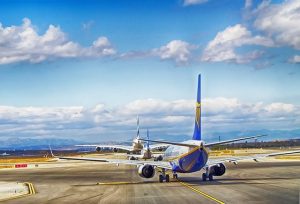 Have you ever wondered how pilots steer airplanes on the runway? When flying, a pilot can control an airplane by adjusting the ailerons. The pilot essentially adjusts the ailerons — flaps found on the edges of the wings — in the desired direction. If the pilot wants to turn right, for example, he or she can adjust the ailerons to point left. On the runway, however, adjusting the ailerons won’t affect the direction in which the airplane is traveling. Instead, pilots must rely on other solutions to steer airplanes on the runway.
Have you ever wondered how pilots steer airplanes on the runway? When flying, a pilot can control an airplane by adjusting the ailerons. The pilot essentially adjusts the ailerons — flaps found on the edges of the wings — in the desired direction. If the pilot wants to turn right, for example, he or she can adjust the ailerons to point left. On the runway, however, adjusting the ailerons won’t affect the direction in which the airplane is traveling. Instead, pilots must rely on other solutions to steer airplanes on the runway.
Tiller
Pilots primarily use a control mechanism known as a “tiller” to steer airplanes on the runway. While often used to describe a soil-shuffling garden tool, the term “tiller” is also used to describe a control mechanism found in the cockpits of many commercial airplanes. The tiller typically resembles an automotive steering wheel, and like regular automotive steering wheels, turning it results in a change of direction. If the pilot wants to steer the airplane left, he or she can turn the tiller to the left.
How does the tiller work exactly? In the cockpit, the tiller is simply a steering wheel. However, it’s directly connected to the airplane’s front landing gear wheels. Therefore, turning the tiller causes the airplane’s front landing wheels to turn in the same direction. Of course, turning the tiller only works when the airplane is on the runway. If an airplane is off the ground — even by just a few feet — the pilot must adjust the airplane’s ailerons to steer it. Turning the tiller only changes the direction of the airplane’s front landing gear wheels, making it ineffective when the airplane is in the air.
Takeoff
During takeoff, pilots use other control mechanisms to steer airplanes. They’ll typically still adjust the tiller to ensure the airplane is aligned with the runway, but they other steering techniques as well, including throttling. With throttling, the pilot can control the amount of power produced by the engines. While this doesn’t necessarily change the direction of airplanes, it allows pilots to achieve and maintain an appropriate speed.
If an airplane attempts to take off too fast, the pilot may inadvertently break the airplane’s front landing gear wheels by adjusting the tiller. To prevent this from happening, pilots use throttling. Throttling simply refers to adjusting the power produced by the airplane’s engines. If the airplane is going to fast, the pilot can turn down the power to maintain control during takeoff.



